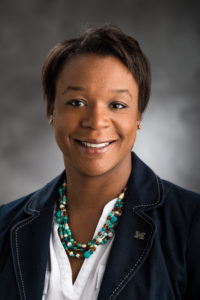2019 CERPP Conference Blog–Day 3
 Session 6. What Research Tells Us About the Consideration of Race
Session 6. What Research Tells Us About the Consideration of Race
Stella Flores, New York University
Flores CERPP 2019 Presentation
Dr. Flores began her presentation, What Research Tells Us About the Consideration of Race, by emphasizing that race in college admissions is really about race in America. She asks: How did we get here? Flores cites race as a factor in admissions, employment, etc. and asks, why are we here again and how do we move forward from this educational Groundhog Day? She notes that we really haven’t come to terms with our past or our future.
Flores reminded us of our history of racism. Law, policy, and educational access and opportunity related to racist ideals and in many ways we are back to that in some location. Transportation, employment, marriage, even where one can use the restroom–was race-based in our recent history. Our new normal is that half of all students in public schools are now non-white. We have the highest number of Black and Latino high school graduates that this nation has ever seen, but that does not translate into admission and college graduation. Segregation in K-12 replicates in higher education; there is an enormous demographic mismatch.
Dr. Flores told research stories, noting that they may have been told before, but effective message translation requires repeating the message.
Educational benefits of diversity, including diversity of Asian students.
There is a well-documented research trajectory related to diversity. Dr. Flores notes that families accept that diversity is key during college but why not for K-12? She focused specifically on Asian students, noting that there has been confusion related to their progress. In regard to the diversity argument, broad holistic policies benefits this population. A well-executed holistic policy should provide a mechanism to fairly evaluate students of all backgrounds. Asian identities should not just be framed in terms of the big countries (Korea, China, Japan) but also include less affluent countries. There are profoundly different opportunities within the Asian population.
The effects of race neutral policies on college admissions–a missing generation of Black students in selective institutions, along with other minority populations. She described this as the” postsecondary elephant” in the room and points to four stories that have been developed over the years (good research areas to explore):
- Race neutral story #1: The effects of the Percent Plan v. AA: What they found in Texas was that students who were eligible in the percent plan, were still not represented at the selective colleges. Any effect of the percent plan was in high schools that already sent the most students to college.
- Race neutral story #2: Whether race-neutral programming is a more efficient admissions system.
- Race neutral story #3: The effects of the bans on AA (8 states as of 2014; institutions within non-ban states also have “bans”)
- Race neutral story #4: Drops in race and ethnic diversity of a student body transcend state policy boundaries given the interdependent market of college admissions
Dr. Flores closed her presentation with the following lessons:
- Beware of misinformation and fear campaigns. Institutional decisions will drive opportunity and progress. Keep and demand research integrity. Know good research.
- Confront inequality and commit to educational equity and diversity in your context. Be creative. Partner with different jurisdictional and organizational entities.
- Be creative with equity solutions in changing higher education market.
During Q&A, Dr. Flores made a very important point that solutions to higher education must be multi-sector and requires collaboration with others, including of course, K-12 institutions.
Stella M. Flores is Associate Dean and Associate Professor at New York University. She is also Director of Access and Equity at the Steinhardt Institute for Higher Education Policy at NYU. Employing quantitative methods, Dr. Flores has written extensively about college success policies at the institutional, state, and federal levels regarding demographic changes in schools, immigrant and English Learner students, Minority Serving Institutions, financial aid, and college admissions. She serves on the editorial boards of various peer-reviewed journals and was recognized as one of the top 20 women in higher education by Diverse Issues Magazine. Dr. Flores is a National Academy of Education/Spencer Postdoctoral Fellow, a top 200 scholar in Education Week’s RHSU Edu-Scholar Public Influence Rankings, and a National Public Radio Source of the Week. Her research has been funded by the Bill & Melinda Gates Foundation, the National Academy of Education, the Spencer Foundation and the Educational Testing Service.
Session 7. Workshop: Considering Race in Admissions: Practical Lessons from the Courts



- Art Coleman, EducationCounsel
- Jamie Keith, EducationCounsel
- Kedra Ishop, University of Michigan
Coleman, Keith, Ishop CERPP 2019 Presentation
The final session of the conference brought together a panel focused on “Considering Race in Admissions”.
Coleman started with a picture of Justice Powell on higher education, diversity, and the consideration of race. Justice Powell basically said educational benefits of diversity could be compelling for some considerations of race. He brought in first amendment and freedom of expression principles.
Bakke: We have had six cases over four decades. We are seeing unparalleled numbers of cases filed in court. There a number of complaints related to scholarships, student support, etc. These cases go beyond race and ethnicity, but also sex and gender. With a newly conservative Supreme Court and an administration that is hostile set of issues, it is challenging. But, he notes, we’ve been there before.
Coleman provides 10 Takeaways from 40 Years of case law (see presentation).
1. Diversity Goals and Rationales. The rows shaded in green (see presentation, Items 1-2 and 8) go towards one fundamental set of interests for both institutional success and legal sustainability. You must have clarity and authenticity on your mission, how diversity fits in your mission, and educational aims with clear goals and objectives for achieving this diversity. You can’t sustain anything or achieve the success you want without this clarity.
2. Policy Design: Items 3-6 on the takeaways. The question of design in the manner in which you consider race is critical.
3. Process: Items 7-10 on the takeaways. You cannot sustain your policies if you don’t have a process of ongoing periodic review.
These three buckets drive home the point that the gatekeeper of EM is no longer just about admissions and EM; it is really about student success and it touches every facet of the institution. There must be targeted ownership across the institution. Please see presentation for “Key Resources: Access & Diversity Collaborative” for further study.
Kedra Ishop began next by suggesting that this work is not about what happens in the admissions offices. There are programs that are happening in student affairs, pre-college enrollment, athletics, etc. There are relevant stories. Ishop urges participants to look into those stories and to colleagues to learn about what they are doing institutionally.
Jaime Keith added to the opening with two key points:
1. Continuing a strong commitment to diversity in higher education because we simply cannot fill our societal and educational role without it.
2. Being very wise about how we approach that work. In a challenging legal environment, legal design parameters must be considered in our approach. Institutions must build the evidence base for whether the diversity that has been achieved is adequate to meet the educational benefits that diversity can bring. Are the strategies that you are pursuing effective? If not–they are not necessary. Don’t be afraid! It is doable–but do it right. Create functional partnerships with the right experts in your institution.
The presentation turned to Key Points of Institutional Focus with three basic areas:
- Compositional Diversity
- Benefits of Diversity/Inclusion
- Equity for All
Coleman led the discussion on Compositional Diversity
- Bakke (1978): Court said absolutely no quotas or separate admissions processes. Treat every applicant as an individual. In that context race can be one factor among may and can even be a tipping factor.
- Grutter and Gratz (25 years later): Grutter further confirmed holistic review and race as a factor among many. Gratz struck down the undergraduate admissions program where points were automatically given to certain populations. The court said it was t0o mechanical. The process must be individualized and nuanced.
- Fisher: Supreme Court question: Show me how race effects the admissions decision of a particular student? Ishop responded: I can’t separate out race, ever. Race is intrinsic to each student and to ever factor we look at for admissions. Race is part of who they are and part of the holistic process.
There is a clear pattern in the focus on the individual, as well as multiple factors or intersectionality. But there is an interesting pass on an important point. The cases and applicants have answered how race is considered. We have not talked about what we mean by race when we are considering it. Is it status, experience, perspective, interests? Are we considering race in ways that tell you about how the students may fit in the institution?
Next, Coleman read a brief from the deans of the law schools at Harvard and Yale (to be posted). This stimulated the discussions and a Q&A session.
Ishop moved the conversation Beyond Compositional Diversity: The Benefits of Diversity and Inclusion. She discussed wealth privilege and the benefits of whiteness. University of Michigan engages in proxies for race, asking students to engage with them in their essays, what the students will contribute, etc., under and within their legal limitations. She asks, What is our responsibility as an institution to be their choice (process)? What is the campus that we present to our students? Larger than who we bring in the door is the question of EM’s role in the campus responsibility to provide the environment.
Ishop emphasizes the importance of understanding where the students are–what do they believe, feel, think about the experience? How are the courses being taught? How are faculty brought into learning how to teach in an equitable manner? Ishop encourages must have the top to bottom commitment in doing this work. The climate that you put forward and what you do to sustain and thrive your student population is important. Otherwise it is just numbers in and numbers out–and students still feel isolated, unwanted, and not connected to the experience that the institution aims to provide. Many of us still have work to do as it takes the work of the president, boards, etc. to make the commitments. But if we are hanging our hat on the benefits of diversity from an educational standpoint, we need to deliver. Ishop continued by emphasizing the importance of transparency–which opens the door for exposing failures. It is what is required, however, to bring everyone to the table and to measure results.
Audience Discussion
Jamie Keith drilled down deeper with her portion, Beyond the Benefits of Diversity and Inclusion: A Comprehensive and Actionable Equity Agenda. Keith emphasized the need to recognize the contributions and limitations of four decades of federal law (Bakke and progeny) to an admissions process that furthers mission is critical to today’s campus focus on interests that extend beyond compositional diversity, the educational benefits of diversity, and inclusion.
She asked the audience to consider this key questions: How do we go back to campus tomorrow and engage leaders at all levels to advance equity and fulfill our educational mission? What can groups like the Center for Enrollment Research, Policy and Practice do? How can we create knowledgeable partnerships that advance equity within the legal boundaries?
The importance of storytelling (rather than just research mode) is critical. Higher education has prevailed on this challenging front, telling the stories grounded in data. This combination is unbeatable. How do we take advantage of the strength and power and conviction that is leveraged when you are sued and use it in a broader and more sustainable way? How can we engage our alumni in telling stories, so that it is not just the institution telling the story?
Art Coleman is a managing partner and co-founder of EducationCounsel LLC. He provides policy, strategic, and legal counseling services to national non-profit organizations and postsecondary institutions throughout the country, where he addresses policy and legal issues associated with student access, diversity, inclusion, expression, and success. Mr. Coleman was instrumental in the establishment of the College Board’s Access and Diversity Collaborative (ADC) in 2004, which he has helped lead for almost 15 years. With a focus on issues of diversity and inclusion, he has authored amicus briefs in Grutter v. Bollinger (2003), Gratz v. Bollinger (2003), and in Fisher v. University of Texas at Austin (I and II, 2013 and 2016). He is widely published in the field, including most recently as co-author of Understanding Holistic Review in Higher Education Admissions: Guiding Principles and Model Illustrations (College Board, 2018).
Jamie Lewis Keith is a Partner at EducationCounsel, which advises organizations on priority policy, strategy, and law issues for higher education. She was previously Vice President, General Counsel and University Secretary at University of Florida and Senior Counsel at Massachusetts Institute of Technology (its primary inside counsel), as well as, earlier in her career, a junior partner at a large international law firm based in Boston and Assistant Commissioner and General Counsel of a Massachusetts agency in Governor William F. Weld’s administration. Ms. Keith has served on the American Association for the Advancement of Science’s advisory board for the Center to Build Capacity in Science and Engineering for 14 years, co-directed the AAAS Diversity and the Law Project, is advising the AAAS SEA Change project, and is an originator of and advisor to the Societies Consortium on Sexual Harassment, an initiative to advance professional and ethical conduct, climate and culture. She served for 14 years on the advisory council for the College Board’s Access and Diversity Collaborative, 10 years on the Association of American Universities’ legal advisory committee, and 3 years on AAU’s Biomedical Research Strategy and Policy Task Force.
Kedra Ishop, PhD, serves as Vice Provost for Enrollment Management at the University of Michigan–Ann Arbor. She is a nationally recognized expert, speaker and advisor on issues in higher education related to diversity, affordability, assessment, admissions and enrollment. She has served on various domestic and international boards for the College Board, ACT, Coalition for College Access, NCAA and others. In overseeing undergraduate admissions, financial aid, new student programs, registrar, marketing and communications, technology, and enrollment research, Dr. Ishop leads a dynamic team in Michigan’s enrollment effort and strategic initiatives. Prior to her tenure at Michigan, she served for 17 years at the University of Texas Austin, departing as Vice Provost and Director of Admissions. Dr. Ishop received her Bachelor’s, Master’s, and PhD In Higher Education Administration from UT Austin.

